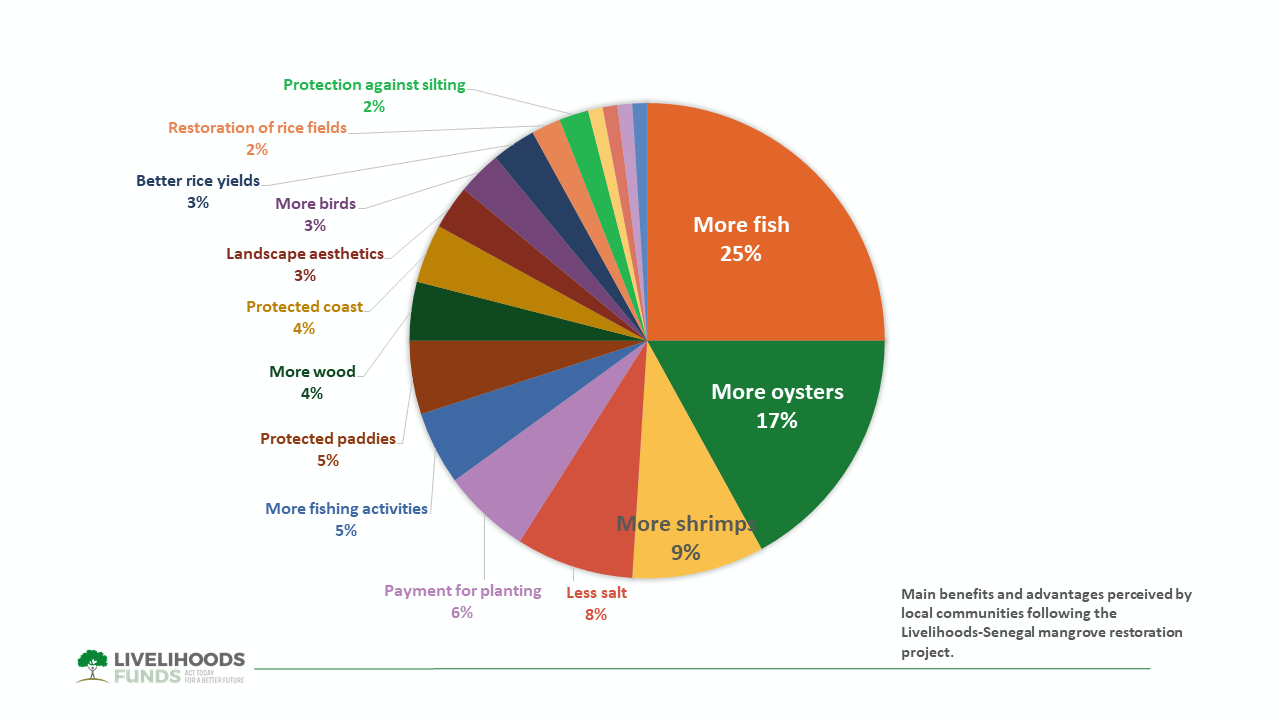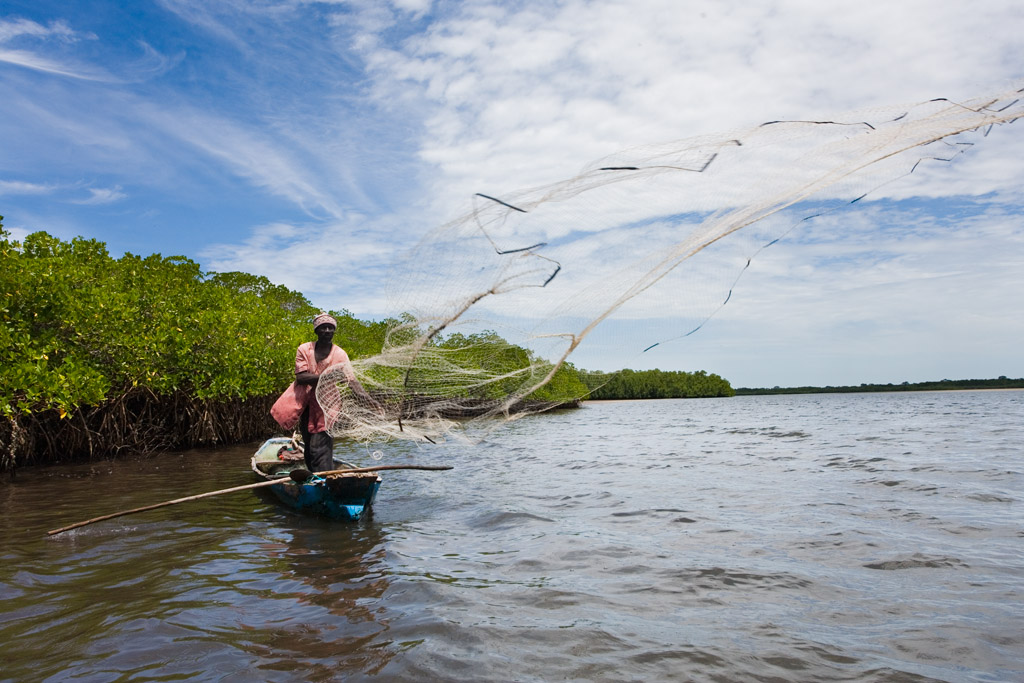10 years after its launch, the Livelihoods Carbon Fund is measuring the social and environmental impacts of its largest mangrove restoration project in Senegal. These results are both surprising and impressive.
In 2009, more than 100,000 Senegalese villagers were involved in a major project to restore the mangroves that provide fish and many other food resources and that had been largely destroyed over the years. In 3 years, they succeeded in planting 80 million mangroves between the estuaries of the Casamance and Siné Saloum rivers. This initiative, led by the Senegalese NGO Océanium, is the largest mangrove restoration program in the world. This project would lay the foundations of the Carbon Livelihoods Fund, with the objective of bringing together private companies, NGOs, local communities, the public sector and civil society in major programs to simultaneously combat environmental degradation, poverty and climate change.
The Livelihoods-Senegal project was financed through carbon finance: the 10 private companies* gathered within the Livelihoods Carbon Fund have invested together in this reforestation program with the dual objective of offsetting part of their CO2 emissions, because mangroves have a high carbon storage capacity in trees and soil, and contributing to the sustainable improvement of the lives of local populations. Verra, one of the main international carbon standards, has certified that this project has already sequestered more than 160,000 tonnes of CO2 out of the 600,000 tonnes expected over its 20-year lifespan.
But, 10 years later, what about the villagers who participated in these replantings? Have they seen an improvement in their living conditions with more food security through a renewal of the stock of fish, shrimp and oysters? Have they been able to replant rice on their lands previously degraded by salt water as a result of deforestation? What do they keep from this extraordinary adventure? To answer all these questions, the Carbon Livelihoods Fund, in partnership with Ramsar[1], IUCN[2] and FFEM[3], commissioned La Tour du Valat, an independent research institute for the conservation of Mediterranean wetlands, and Océanium, the Senegalese NGO that implemented the Livelihoods-Senegal project, to conduct a study in the villages that participated in the project to assess its social impact. The main results of this study, conducted in 2018, are presented below.
The Livelihoods-Senegal project in pictures
[soliloquy id=”10508″]
A people-centered methodology
The study of the social impacts of the Livelihoods-Senegal project was carried out over a period of 4 months in about 50 villages that participated in this initiative. More than 850 community and individual interviews were conducted to establish a representative sample of a complex that the Institut La Tour du Valat estimates at more than 50,000 households and 550,000 people.
The methodology chosen, the “Sustainable Livelihoods Approach” developed by the British International Development Agency (DFID), is based on both people’s perceptions and observation of change. It was designed to measure the social impacts of a project on livelihoods. The term ‘livelihood’ includes capacities, assets (including material and social resources) and activities required for subsistence. Livelihoods are considered sustainable when local people can cope with shocks while maintaining or improving their capacities and assets, without depleting their natural resources. [4]
To conduct the interviews, Laurent Chazée, international project manager at the Tour du Valat, trained 18 Senegalese auditors for a week in Ziguinchor, a city in Casamance. Divided into pairs, the listeners then went into immersion for several days in different villages, most of them accessible by canoe because they were far from the road networks, to conduct community and individual interviews.
By analysing the villagers’ testimonies, the methodology makes it possible to categorise the project’s effects and to understand which tangible factors – linked to the project or not – are being implemented. In order to verify the relevance of the impacts identified by the communities, the testimonies are cross-referenced with objective observations of the changes that have taken place in the villages (for example, the provision of gas ovens, solar collectors or mobile phones, access to water or sanitation).
Surprising & impressive results
The study conducted by La Tour du Valat revealed an important result: the Livelihoods-Senegal project is still very much in people’s minds and is one of the collective actions of which the villagers are still the most proud of to this day. More than 85% of villagers consider that planted mangroves have good growth. During the discussions, many residents indicated that they had participated in this project to provide a better environment for their children and grandchildren. Some even think that without the reforestation, they would have left the land of their ancestors. They establish a direct link between the restoration of mangroves and improvements in their living conditions. Thus, 95% of villagers believe that mangroves have had at least one positive impact on their lives.
The improvement of biodiversity and the increase in the number of fish and oysters are the benefits that top the list of villagers. This increase is directly related to the restoration of the mangrove ecosystem that supports the reproduction, feeding and protection of fish and shrimp. The roots of mangroves favor the attraction of oysters, which in turn find excellent conditions for their development.
The Livelihoods-Senegal project is one of the collective actions of which the villagers are still the most proud of to this day
The improvement of biodiversity and the increase in the number of fish and oysters are the benefits that top the list of villagers. This increase is directly related to the restoration of the mangrove ecosystem that supports the reproduction, feeding and protection of fish and shrimp. The roots of mangroves favor the attraction of oysters, which in turn find excellent conditions for their development.
Main benefits and advantages perceived by local communities following the Livelihoods-Senegal mangrove restoration project according to the study conducted by the research institute La Tour du Valat.
(The percentages correspond to the number of times each benefit or advantage was mentioned first by the communities).
In 60% of the villages, fishermen now have more substantial catches, allowing them to sell their catches in the surrounding villages as far as Cap Skiring. This increase in fishery resources also benefits multi-family households, resulting in improved food security and increased income. Women can once again catch fish and collect oysters for their own consumption or for sale in villages or along the roads. In addition, greater availability of fish in all seasons has led to lower prices on the shelves, making it more accessible to the most vulnerable families. The Institut La Tour du Valat estimates that the restoration of mangroves has led to an increase in fish stocks of more than 4,200 tons per year.
The study also highlighted a related benefit of the Livelihoods-Senegal project on rice field restoration. Planted mangroves now act as a protective barrier against salt water. Gradually, the rice fields along the coast are emptying all the salt that used to suffocate them. Farmers are harvesting again on plots that they had been forced to abandon because of salinization. Further inland, other farmers are seeing their yields increase as the land recovers its access or accessibility to the sea. The study estimated that 15% of previously abandoned rice fields could be restored and that rice fields further offshore could increase their yields by 10% and more. Although the complete restoration of the rice fields alone is a major project to complement the restoration of mangroves, the inhabitants believe that the growth of mangroves will continue to improve rice growing conditions.
In addition to the direct impact of mangrove restoration on food security, villagers’ incomes and climate change, the study conducted by La Tour du Valat highlighted other impacts ranging from strengthening community cohesion to the availability of timber or fuelwood, as well as the beauty of the landscape. What emerges from the surveys is the strong ownership of this project by the villagers. For 93% of the villages surveyed, the reforestation technique proposed by the NGO Océanium, simple and reproducible by all, is the first lesson they retain from the project. 25% of the 450 villages mobilized in the Livelihoods-Senegal project continued mangrove restoration campaigns on their own initiative. And more than 70% of the villages have set up monitoring of their mangroves with rounds to protect their forests from illegal logging. The impact study conducted by Tour du Valat confirmed a key factor for the success of this project: it enabled the villagers themselves to be the actors in the preservation and sustainable use of their natural resources.
When long-term corporate commitment and carbon finance create a virtuous circle
Without the mobilization of the villagers of Casamance and Siné Saloum and the incredible social engineering of Océanium, the 80 million mangroves of the project would not stand today as a rampart against climate change and at the same time as a nourishing ecosystem for the inhabitants. Carbon finance has enabled vulnerable communities to restore their mangroves through the commitment of private companies that have committed to investing in sustainable projects. In return for their investment in the Livelihoods-Senegal project, the companies of the Livelihoods Carbon Fund receive carbon credits with high social and environmental value to offset their CO2 emissions. Investors in the Carbon Livelihoods Fund have provided Océanium with the necessary funding for replanting (population awareness, validation of scientific models, intervention logistics, etc.) and are going to continue to finance its monitoring and evaluation until 2029, for a total duration of 20 years.
*Crédit Agricole, Danone, Firmenich, Groupe Caisse des Dépôts, Hermès, La Poste, Michelin, SAP, Schneider Electric, Voyageurs du Monde.
[1] The Convention on Wetlands, called the Ramsar Convention, is the intergovernmental treaty that provides the framework for the conservation and wise use of wetlands and their resources.
[2] The International Union for Conservation of Nature (IUCN) is uniquely composed of both government and civil society organisations. It provides public, private and non-governmental organisations with the knowledge and tools that enable human progress, economic development and nature conservation to take place together.
[3] The French Facility for Global Environment (FFEM) has a mandate to promote the protection of the global environment in developing countries since its creation by the French Government in 1994.
[4] http://www.livelihoodscentre.org/-/sustainable-livelihoods-guidance-sheets
Photos: Hellio-Vaningen/ Livelihoods Funds.




